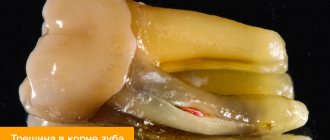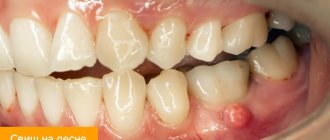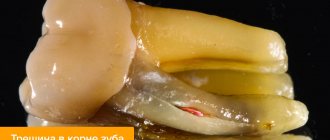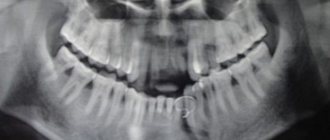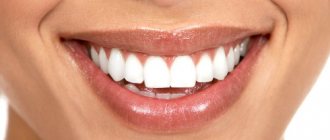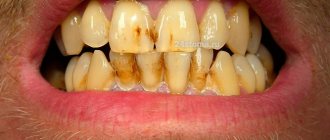05.08.2021 617
There are a large number of reasons why a person could potentially suffer such an injury. In this case, there can be a lot of unpleasant consequences - from a simple violation of aesthetics to severe pain, hypersensitivity to cold or hot food.
Let's look at why chips may appear and what the consequences are. We will also touch upon the issue of prompt home treatment in such a situation, as well as a method for solving the problem by a professional dentist.
The most common causes of chipped teeth
Human teeth are very strong. They are well protected from external mechanical influences and are designed specifically to cope with tough, fibrous foods. However, there are many factors that could potentially lead to chipping.
When you make an appointment with your dentist, he or she will conduct a thorough examination of your mouth and determine what may be causing the problem.
Typically, chips occur as a result of several common reasons:
- Inattentive food selection. You can chip a tooth when chewing if there is something too hard inside the food. It could be a small stone, a mollusk shell, and much more. The danger is especially great if you actively chew food and cannot sense in time that something is wrong.
- External trauma. Often happens when hit, fallen, or involved in a traffic accident. There is also a danger of collateral injuries. This may include tooth dislocation, gum damage, wounds on the tongue, or the oral mucosa.
It is also important to understand that the strength of a person's teeth may vary depending on many factors. There are several factors that significantly increase the likelihood of chipping:
- Violation of the acidity of the oral cavity.
- Enamel diseases.
- Cracks on the surface of the tooth.
- Severe damage to the seal.
- Malocclusion and other congenital deformities.
- Bruxism.
People with bad habits are also at risk. Excessive consumption of alcohol and smoking leads to teeth becoming much more fragile.
If a person belongs to a risk group, a chip may appear even from not the strongest pressure. Therefore, it is worth monitoring the condition of your teeth and taking timely measures. So, if you suffer from bruxism and grind your teeth a lot at night, you should choose mouthguards on the advice of your dentist to reduce the negative impact.
Some people also experience chipping simply because they are inattentive to their diet. They actively chew on candy and nuts and open their jaws too much while chewing food, which significantly increases the potential for injury.
Sometimes the problem takes on a systemic nature and indicates negative changes in the body, a lack of certain nutrients from food. In this case, the answer to the question of why teeth may break off specifically in your case is given by a comprehensive examination.
Tongue traumatism: theory
Before you begin treatment of the tongue, you should carefully study the nature of the injury and its causes.
The first type of damage - mechanical - is the most common cause of tongue injuries. Due to mechanical damage, ulcers and superficial erosions form on the tongue.
Conditions under which mechanical injuries occur are of a domestic nature:
- damage to the integument by dental instruments - probe, bur, disc;
- the occurrence of a wound under the influence of a sharp object - a bone, a knife, a fork;
- biting the tongue while eating, epileptic seizure;
- the appearance of tongue injuries from blows to the face.
Healing of a wound caused by mechanical impact occurs depending on the depth and area of damage to the mucous membrane.
Chemical burn
Chemical injury to the tongue, as the second type of injury, occurs due to contact with the mucous membrane of a chemical substance of an acidic or alkaline nature.
Under the influence of an irritant, chemical burns occur on the tongue. The latter are characterized by the appearance of dark-colored areas, scars, blisters and blisters on the tongue (in severe cases).
Instant rinsing of the mouth with solutions with neutralizing properties is the key to rapid restoration of the integument.
For chemical burns, it is preferable to seek help from medical institutions.
Damage to the mucous membrane by steam, hot water, fire, electric current or ionizing radiation is called physical trauma to the tongue.
Characteristic of this type of injury is pain that gradually subsides from the moment of injury.
The main danger of physical injury is the development of acute catarrhal glossitis (inflammation). Consultation with a doctor in complex stages of injury is mandatory.
Deep damage to the tongue caused by various kinds of external irritants can be accompanied by complications: abscess or phlegmon of the tongue.
Painful swelling and accompanying difficulties with swallowing and speaking are symptoms of an abscess. In later stages, with increasing inflammation of the tongue, the abscess turns into phlegmon. The victim requires emergency hospitalization and surgical intervention.
Signs of chipping
In most cases, chips can be identified by visual inspection or when the patient simply touches the tooth with his tongue. But there are also situations when the chip is located on the inside, difficult to reach and difficult to inspect.
Such situations reveal themselves as a whole list of symptoms. These include the following:
- Problems with chewing food, something constantly gets in the way, pieces begin to get stuck inside the tooth.
- The loss of a previously installed filling (a chip forms on the remaining part of the tooth and it simply cannot hold on normally).
- Severe sensitivity when eating - a reaction occurs to sour, salty, cold, hot foods.
- Acute pain and severe pulsation at the site of injury.
It is worth understanding that the size and nature of chips may vary. Because of this, some patients may not even notice the problem, while others experience severe pain - their nerve is exposed. Regardless of the degree of destruction, you should consult a doctor as soon as possible and conduct a detailed examination of the oral cavity.
Causes
Calluses are often confused with stomatitis and pemphigus. This comparison is incorrect, since the main reason for the appearance of calluses is systematic trauma to the oral cavity.
In infants, injury occurs during feeding, especially if it is carried out not according to time, but at the request of the baby, and he remains at the breast for a long time. Rubbing of the thin mucous membrane occurs, as a result of which seals can appear not only on the tongue, but also on the palate and upper lip.
Adults suffer from the pathology most often after eating seeds, nuts, chewing candy and other hard foods. They may develop calluses on their gums or the roof of their mouth from wearing braces.
If wisdom teeth erupt incorrectly, sores may appear on the inside of the cheeks due to constant trauma.
A callus forms on the tongue after carelessly consuming hot food or drinks. Trauma to the mucous membrane occurs, which leads to tissue necrosis.
Main types of damage
The choice of treatment method directly depends on how badly the patient’s tooth is damaged. There are several common manifestations, which include the following:
Crack in the enamel.
- The enamel itself is very durable, which is not surprising - it acts as the main protective mechanism throughout life. There are many factors that can lead to the appearance of microcracks in the surface. From the outside, they are often very difficult to distinguish, but they can not only increase in size, but also become the cause of common oral diseases, such as caries. Food gets packed into the cracked areas and bacteria actively multiply in them. At the same time, the strength becomes less and the likelihood of a large chip only increases. The standard cause of the problem is an incorrect diet, eating a lot of sweets.
- Chipping of part of the enamel. A lacuna appears on the tooth, which is often clearly visible even during an external examination. There is pain and an acute reaction when eating various types of food. It is worth consulting a doctor as soon as possible to prevent the problem from getting worse.
- Skol. It differs in location and size. Depending on the nature of the injury, it appears on both the external and internal sides of the tooth and is clearly visible during the initial visual examination. The injury is accompanied by hypersensitivity, severe pain, pulsation and other noticeable negative manifestations.
Injuries in which the tooth is chipped at the root are also common. They are the most dangerous for humans, because in this case the nerve is exposed and the patient begins to experience severe physical suffering. Further actions in case of injury will depend on the condition of the remaining part of the tooth. Removal of the root is required, but sometimes it is possible to use the remainder as a base for a crown.
In our clinic, doctors fight for every tooth. We do everything to restore aesthetics, chewing ability and relieve you of pain.
Prevention from chips
The best prevention against chipped teeth is daily oral hygiene and timely visits to the dentist.
You should also be less involved in extreme sports and avoid life situations that can lead to mechanical damage to the jaw and teeth in particular. It is also not recommended to eat too hard foods (nuts, seeds).
Careful hygiene - prevention of tongue wounds
All of the situations described above are very unpleasant, so you need to watch your teeth very carefully. Dental health directly affects the gastrointestinal tract, and therefore the functioning of the entire body. Therefore, it is very important that your teeth are in perfect condition.
First aid at home for a chipped tooth
Sometimes the injury occurs late in the evening or it is impossible to make an appointment with a doctor the next day. In this case, you need to take the right steps to prevent infection, relieve pain, and rule out most other potential problems.
At home, several actions are taken depending on how severe your injury is and what signs it is accompanied by:
- Mouth rinse. Note that as soon as a tooth chips, you need to stop swallowing saliva until you rinse your mouth. Rinsing is done gently, without creating a vacuum or strong pressure on the affected side. To ensure quick disinfection, you can also use a chlorhexidine solution.
- Application of a special compress. This is necessary in order to minimize swelling. At home, use a towel soaked in cold water or a special ice bag, which we recommend keeping on hand. If there is no such bag, put the ice in a bag and wrap it with cloth. The same towel will work well.
- Taking painkillers. This allows for temporary relief of pain. If you do not have any contraindications, you can use products with an additional anti-inflammatory effect. These include such as Ibuprofen, Dolaren and others. When the patient does not have individual intolerance to drugs, and the chip is large, it is practiced to place a tampon soaked in lidocaine or novocaine inside. The measure is needed to significantly reduce pain and prevent pathogenic bacteria from entering the chipped tooth.
A special situation arises if a person experiences severe bleeding. In this case, rinsing is contraindicated. The tooth itself can be covered with a turunda for additional protection.
If you have a chip, you need to see a doctor as soon as possible. When a tooth is chipped at the root, we recommend saving the remaining part - it will be needed for subsequent restorative procedures.
It is not recommended to delay going to the doctor. The reason is that there is a high probability of infection and gradual further spread of the process.
Traditional treatment
If a lump is found in a child, it is not recommended to resort to using any folk remedies on your own, as they can negatively affect the baby’s condition.
For adults, rinsing with antibacterial compounds is perfect. They will help prevent the development of inflammation in the injured area of the mucosa, and will also help maintain the cleanliness of the oral cavity. An important addition: you can use traditional methods only if there are no allergic reactions to herbs. Otherwise, it is better to refuse alternative treatment. The most effective recipes are described below:
- Salt rinse. To do this, dissolve a teaspoon of sea salt in a glass of warm water. Rinse your mouth after eating; after treatment, you should stop eating for at least an hour.
- Chamomile decoction. It is most convenient to use ready-made filter bags, which are sold at the pharmacy. You need to fill one such packet with a glass of boiling water, let it brew and use it to treat the oral cavity.
- Calendula. For this rinse you will need an alcohol solution. Twenty drops of tincture are dissolved in a glass of warm water and used after any meal, preferably before going to bed.
- Propolis. This beekeeping product has excellent antiseptic and healing properties . It is used in the amount of one teaspoon per glass of warm water.
The above recipes are not only effective, but also affordable, and if used regularly, they will help to avoid infection of the oral cavity.
Types of professional medical care
When a patient sees a dentist, he carefully assesses the situation. Depending on the initial state, there may be many options for action. These include:
- Remineralization. This method is used if a small crack occurs in the enamel. Either an individual tooth or the entire row can be treated with a special strengthening preparation. A special product is used, which contains a sufficient amount of various trace elements and minerals. The technology allows you to get rid of cracks and significantly strengthen the tooth.
- Application of preparations with a high fluoride content. This is also necessary in order to significantly improve the overall condition of the enamel. The patient is prescribed a special mouthguard, onto which such material is applied. This makes it possible to provide treatment around the clock.
- Artistic restoration. This method is needed specifically to restore the aesthetics of the oral cavity. The method is used if the chip is small. Modern technologies are needed to restore the shine of enamel. The color of the restored fragment will not differ from the surrounding row.
- Installation of additional cover. One of the most common methods of restoring dental aesthetics without the use of complex and lengthy operations. We use various types of overlays – these can be lumineers and veneers. The composition, duration of use, appearance and many other characteristics differ.
- Placement of a special crown. The approach can be used if the upper part of the tooth is not severely damaged. The remaining part of the tooth in this case begins to be used as a natural support. The crown will be stable and will completely fill the vacated space.
- Using special tabs. At the same time, the order for the production of such an onlay is transferred to a special dental laboratory. The overlay is very durable and restores chewing ability.
Sometimes, as a result of strong pressure, the tooth root itself breaks. This is the most serious situation in which proper removal of tooth remains and subsequent implantation will be required. A base is installed in the gum, on which a special crown is fixed.
First aid
If it is impossible to contact a specialist at the moment, try to give yourself first aid yourself.
- Rinse your mouth thoroughly, but not too vigorously, with a weak saline solution (optimally sterile saline) or plain warm water. This will help you remove enamel chips and small food particles from the damaged area;
- In case of injury or bleeding of the gums, it is recommended to apply a piece of sterile bandage to it. At the same time, it is not advisable to moisten it with an antiseptic if it is quite aggressive (alcohol);
- Apply ice to the cheek on the side of the damaged tooth. This will help prevent swelling;
- Take a pain reliever if the pain gets worse.
As soon as it is possible to go to a dental clinic, make an appointment. This will help to avoid dangerous consequences and qualitatively restore a broken tooth.
Chip in the front row of teeth
Typically, such chips occur when biting or a strong blow. Even the smallest defects are noticeable on the front row, so a small chip can cause not only discomfort, but also psychological problems. Also, the aesthetics are spoiled by microcracks, which over time begin to turn black and become more and more visible.
When small cracks appear, fluoridation and mineralization are usually sufficient. If the enamel has been severely damaged and part of the tooth has broken off, installing an artificial veneer would be a good solution. In our clinic, your dentist will install veneers or ultraneers for you. If the damage is severe, the only option is removal, prosthetics or implantation.
Rubbing your tongue on your teeth, what to do?
The tongue is an important organ in the human body, but it is remembered only when it begins to hurt.
The tongue can get sick not only from infection, but also from mechanical stress. What does it mean? The tongue rubs against the uneven edges of the teeth. The most common situation is the chipping of a small section of a tooth. Such a nuisance can happen to anyone. As a result, the uneven edges of the tooth begin to cause discomfort, interfere with normal eating and cause pain during conversation.
Wounds on the sides of the tongue - marks from teeth
If you delay treatment of an injured tongue for a long time, you can get serious inflammation, which can lead to infection of the entire oral cavity.
Chip on the side of the tooth
Most often occurs during chewing. Since this is a side invisible to prying eyes, many patients decide not to see a doctor at all and live with such a defect.
This approach is wrong for several reasons:
- A chip can easily become a site for the development of caries and the situation will only get worse.
- Due to the strong pressure on the damaged area, further destruction is possible.
- There is a risk of injury to the tongue when it comes into contact with a sharp edge and the onset of an inflammatory process.
The advantage of working with the sides is that aesthetics matter less. Therefore, you can get by with less expensive materials during the restoration process. The strength itself will not become lower.
A fragment remains after tooth extraction: why does this happen?
A tooth is an integral organ that consists of a crown and root parts. If a root or splinter remains after tooth extraction, it means the tooth has lost its integrity. This occurs due to mechanical stress during removal. Tooth destruction during extraction occurs for a number of reasons.
- Doctor's mistake.
Lack of doctor qualifications is a fairly common cause of complications. Incorrect tooth extraction technique can lead to the destruction of even a relatively strong tooth. - Poor condition of the tooth root.
If the root of the tooth remains in the gum, this is often due to the fact that the root part was in poor condition, so when you try to remove it, the tooth literally breaks into two parts. - When removing a tooth,
the neighboring one was hit, and a fragment from it fell into the socket. This happens quite rarely, but it still happens. This situation is also a consequence of incorrect extraction technique.
Occurrence of a vertical crack
Sometimes a chip does not appear, but the tooth cracks vertically - this is very noticeable from the outside. The choice of treatment method will be based on how severely the enamel is damaged and how deep the crack goes.
There are three main treatment options:
- Standard filling.
- Installation of external onlays on the tooth.
- Removal and subsequent implantation.
It is important to resolve the problem quickly before numerous potential complications arise.
Do children need to treat chipped teeth?
Parents often ask the question of what to do if a child’s tooth chips. Many people believe that baby teeth are not that important and therefore need not be treated. The logic is simple - they will fall out on their own and be replaced by indigenous ones.
But you should not be guided by this logic for a simple reason - the condition of the baby tooth greatly affects the formation of the molar. The onset of the inflammatory process and infection of the tooth lead to inflammation of the gums. This can negatively affect the formation of permanent dentition.
What to do
If the tongue is rubbed by a tooth, then it is necessary to assess the degree of chipping. Small chips smooth out quite quickly on their own and no longer cause discomfort. There is no need to treat this tooth, because it does not pose any danger.
All small wounds and abrasions on the tongue will heal very quickly.
To speed up the tongue recovery process, you should refrain from hot, salty and spicy foods. The pharmacy sells special creams and gels that can be used to lubricate damaged areas on the tongue.
Broken tooth requires treatment
Well relieves inflammation using lotions using sea buckthorn or rosehip oil. Apply a moistened cloth to the damaged area for 10–15 minutes. The procedure must be carried out three times a day.
Before going to bed, you can rinse your mouth with propolis tincture. It needs to be diluted more with water. You can simply anoint the rubbed areas with honey.
If a large section of a tooth has chipped, then you cannot do without a dentist. The dentist will sand down all sharp edges and treat them with a special product. It may be necessary to restore the tooth or even resort to prosthetics.
Contacting your dentist will help eliminate the cause of the rubbing.
What to do if it is not possible to go to the dentist in a timely manner, and your tongue begins to rub on your teeth. This situation can happen during a vacation outside the city.
In this case, you can use improvised means. To help smooth out sharp edges:
- file with fine abrasive;
- glass nail file;
- sandpaper with the finest grit.
Clear teeth marks on the tongue
The selected item is first soaked in alcohol or any disinfectant. Light stroking movements smooth out the damaged area. Do not press too hard, otherwise the enamel and gums will be damaged. It is recommended to use this method only in extreme cases.
If a broken tooth has caries and a dark spot appears after a chip, then you should not put off visiting the dentist for too long. Dark staining of the enamel indicates that a destructive process has been activated in the tooth tissues. If the tooth is not treated in time and a filling is not placed, it will have to be removed in the near future.
Injury from sharp edges of fillings
Sometimes, due to serious facial injuries, it happens that a piece of the tooth breaks off below the gum level. In this case, the pain will be very intense. With a deep chip, the gums can be injured. Sometimes a nerve is even exposed. In such a situation, you should immediately consult a doctor. The specialist will take a photo and decide whether the tooth can be healed or whether it will have to be removed. If immediate contact with a doctor is unrealistic, then it is recommended to rinse your mouth as often as possible. For rinsing, it is better to use a decoction of chamomile or sage. If you experience severe pain, you need to take a painkiller.
What complications can you encounter due to chips?
If you notice a chip on your tooth, you should contact your dentist as soon as possible to have it repaired. And it's not just about aesthetics. Delay will cost the health of your smile. There are several potential complications that have to be encountered in medical practice:
- Tooth infection. Any pathogenic bacteria can penetrate through the open pulp. As a result, the person not only suffers from pain. Previously, only a slightly damaged tooth that could still be saved had to be removed.
- Periodontitis. This is the name of a strong inflammatory process that occurs in the tissues surrounding the apex of the tooth root. Treatment is long and complex and may require removal.
- Formation of neoplasm. They can be of either granulosa or cystic type and pose a serious danger to the human body.
- Changes in bite and dental mobility. It is formed due to the fact that it becomes inconvenient for a person to close his jaws. There are many types of complications due to this reason.
The development of severe sensitivity to food, which over time develops into pain, is also characteristic. You cannot delay treatment - contact a doctor as soon as possible.
Nutrition: prevention of inflammation
If gingivitis is the cause of pain when pressing on your gums, it is important to review your diet by including healthy foods in your diet. To prevent future diseases, first of all, you need to consume plenty of fresh fruits and vegetables:
- Apples and pears contain a lot of pectin, which helps accelerate tissue regeneration.
- Citrus fruits are a real storehouse of vitamin C, which also helps reduce bleeding and inflammation.
- Black currants, blackberries, and raspberries contain a large amount of minerals and vitamins that increase the body's resistance.
- Carrots, cabbage and zucchini are valuable fiber and vitamins that enhance metabolic processes in the body and accelerate tissue regeneration.
To prevent gum inflammation, professional teeth cleaning is also recommended. The procedure is carried out by a dentist and allows you to eliminate all accumulated deposits and tartar.
So, now you know the most common causes of pain in the gums when pressing. Remember: when your gums or teeth bother you, you should never put off visiting the dentist. The sooner the doctor determines the cause of the problem and begins treatment, the greater your chances of saving your teeth, gums and avoiding possible complications.
Sources:
- The role of anti-inflammatory rinse in the treatment of periodontal diseases (L.Yu. Orekhova, A.A. Leontyev, S.B. Ulitovsky) L.Yu. OREKHOVA, Doctor of Medical Sciences, Prof., Head of Department; A.A. LEONTIEV, dentist; S.B. ULITOVSKY, Doctor of Medical Sciences, Prof. Department of Therapeutic Dentistry of St. Petersburg State Medical University named after. acad. I. P. Pavlova
- Clinical studies of antisensitive toothpaste “Asepta Sensitive” (A.A. Leontyev, O.V. Kalinina, S.B. Ulitovsky) A.A. LEONTIEV, dentist O.V. KALININA, dentist S.B. ULITOVSKY, Doctor of Medical Sciences, Prof. Department of Therapeutic Dentistry, St. Petersburg State Medical University named after. acad. I.P. Pavlova
- The effectiveness of the use of Asept “adhesive balm” and Asept “gel with propolis” in the treatment of chronic generalized periodontitis and gingivitis in the acute stage (Municipal Dental Clinic No. 4, Bryansk, Kaminskaya T. M. Head of the therapeutic department Kaminskaya Tatyana Mikhailovna MUZ City Dental Clinic No. 4, Bryansk
How to prevent chipping
There are several tips that dentists give to patients in order to keep their teeth intact for as long as possible. These include:
- Maintain good oral hygiene. Use high-quality pastes, rinses, special gels as recommended by your doctor. The enamel needs to be strengthened.
- Visit your dentist regularly. It is necessary to carry out proper dental treatment, to ensure that the enamel does not crack or wear off.
- Monitor the condition of the gastrointestinal tract and other body systems. Particular attention should be paid to the functioning of the endocrine and immune systems. Changes in the balance of acidity in the oral cavity should not be allowed.
- Form your diet correctly. It should include foods that stimulate strong bones and teeth.
- Correct your bite. Due to improper bite, chips appear quite often, and the enamel itself is worn away ahead of time. It is cheaper to get braces than to periodically spend money on veneers, implantation, remineralization and other dental procedures.
- Cure bruxism. This may require you to wear special mouthguards.
Equally important is the advice to monitor what and how you eat. Try not to chew on anything too hard—candy, nuts, and more. If you chew carefully and watch what you eat, the likelihood of chipping will be much less.
Recovery methods
When restoring the aesthetics of the dentition, dentists use different restoration techniques :
- composite material;
- tabs;
- veneers and lumineers;
- crowns
In this review, we described in detail the types of Splat toothpastes.
Composite material
It is used for minor chips and breaks that do not affect the internal layers. The materials used are composites that acquire their final shape after exposure to light radiation.
The doctor works with this material directly – in the patient’s oral cavity.
The procedure is completely painless and performed quickly. The dentist applies pre-prepared material to the area of the tooth. The patient acquires a ready-made tooth after 30–50 minutes of doctor’s work.
Veneers and Lumineers
Used to disguise chips on the side and front teeth. By covering them, these plates not only restore the beauty of the smile, but also further strengthen the strength of the enamel.
We will quickly and efficiently deal with chipped teeth
At our clinic, doctors are ready to quickly treat chipped teeth and any other injuries or damage. We use advanced techniques - from remineralization to installation of onlays and implantation.
We offer our clients affordable prices and are always ready to answer any questions they may have. We will relieve you of pain, restore the aesthetics of your smile and the ability to chew normally. We have affordable prices and special offers.
To learn more about the treatment process and make an appointment with a dentist at a convenient time, leave a request on the website or call us at the numbers provided.


